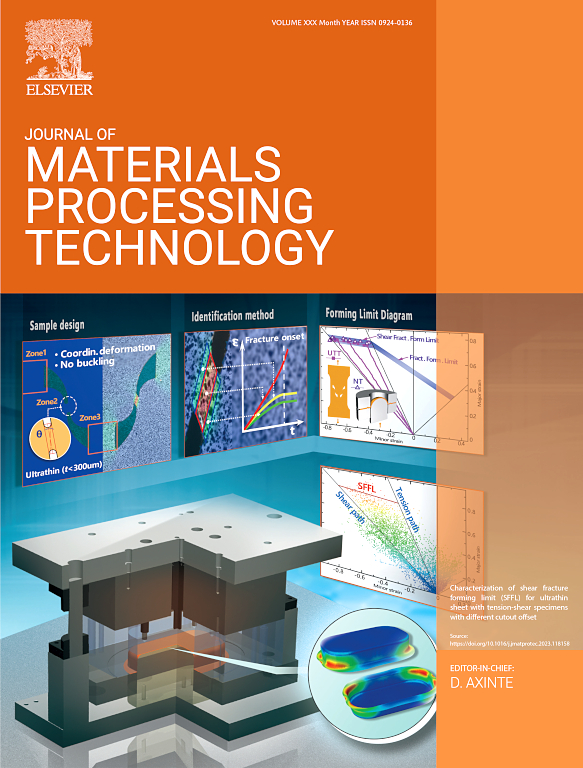Fabrication of different shapes of tool electrodes using a variable-parameter bipolar-pulsed liquid membrane electrochemical etching method
IF 6.7
2区 材料科学
Q1 ENGINEERING, INDUSTRIAL
Journal of Materials Processing Technology
Pub Date : 2025-03-17
DOI:10.1016/j.jmatprotec.2025.118798
引用次数: 0
Abstract
With traditional liquid membrane electrochemical etching methods, it is difficult to effectively control the electrolytic products. In this paper, a variable-parameter bipolar-pulsed liquid membrane electrochemical etching technique is proposed for the preparation of microelectrodes. The introduction of negative voltage will generate insoluble electrolytic products on the electrode surface. By adjusting the processing parameters, these electrolytic products can be precisely controlled, thereby shaping the morphology of the electrodes. In step one, the positive voltage is larger and the electrode surface is coated with a layer of insoluble electrolytic products. In step two, the positive voltage is smaller and hydrogen is generated on the electrode surface, dispersing the electrolytic products. The effects of positive voltage, negative voltage and processing time on the distribution of electrolytic products and electrode morphology were investigated in different steps. It was found that the upper and lower electrodes changed significantly with the change of processing time. Based on the experimental results, the droplet-shaped upper electrode and conical-shaped lower electrode with tiny size and controllable shape were prepared. In addition, a repeated-variable-parameter method was used to mitigate the problem of inconsistent etching speed that was caused by the electrolytic product coating, and enabled the preparation of cylindrical electrodes that are uniform in size. While keeping the processing mode unchanged, different shaped electrodes can be manufactured by simply adjusting the parameters to control the distribution of electrolytic products, demonstrating good processing flexibility.
用变参数双极性脉冲液膜电化学刻蚀法制备不同形状的工具电极
传统的液膜电化学蚀刻方法难以有效控制电解产物。本文提出了一种可变参数双极性脉冲液膜电化学刻蚀技术,用于制备微电极。负电压的引入会在电极表面产生不溶性电解产物。通过调整加工参数,可以精确控制这些电解产物,从而塑造电极的形态。在第一步中,正电压较大,电极表面涂有一层不溶性电解产物。在第二步中,正电压较小,在电极表面产生氢气,使电解产物分散。在不同的步骤中,研究了正电压、负电压和处理时间对电解产物分布和电极形貌的影响。结果表明,上、下电极随加工时间的变化有明显的变化。在实验结果的基础上,制备了尺寸微小、形状可控的水滴状上电极和锥形下电极。此外,采用了重复变参数方法来缓解由电解产品涂层引起的蚀刻速度不一致的问题,并使制备尺寸均匀的圆柱形电极成为可能。在保持加工方式不变的情况下,通过简单调整参数来控制电解产物的分布,就可以制造出不同形状的电极,具有良好的加工灵活性。
本文章由计算机程序翻译,如有差异,请以英文原文为准。
求助全文
约1分钟内获得全文
求助全文
来源期刊

Journal of Materials Processing Technology
工程技术-材料科学:综合
CiteScore
12.60
自引率
4.80%
发文量
403
审稿时长
29 days
期刊介绍:
The Journal of Materials Processing Technology covers the processing techniques used in manufacturing components from metals and other materials. The journal aims to publish full research papers of original, significant and rigorous work and so to contribute to increased production efficiency and improved component performance.
Areas of interest to the journal include:
• Casting, forming and machining
• Additive processing and joining technologies
• The evolution of material properties under the specific conditions met in manufacturing processes
• Surface engineering when it relates specifically to a manufacturing process
• Design and behavior of equipment and tools.
 求助内容:
求助内容: 应助结果提醒方式:
应助结果提醒方式:


